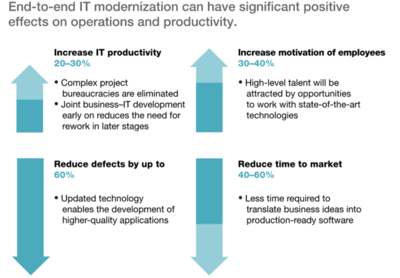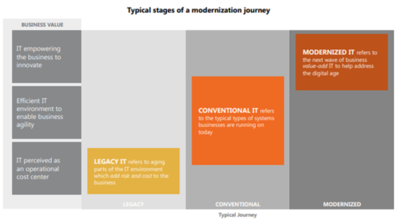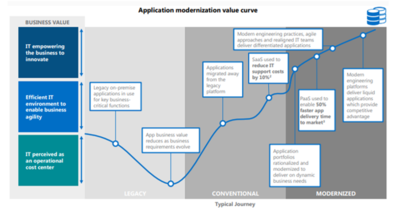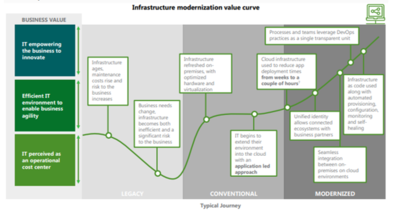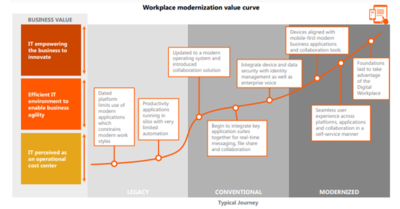Difference between revisions of "IT Modernization"
m (→See Also) |
|||
| Line 116: | Line 116: | ||
==See Also== | ==See Also== | ||
| − | [[Application Modernization]] | + | *[[Application Modernization]] |
| − | [[Application Modernization Services]] | + | *[[Application Modernization Services]] |
| − | [[IT Cost Optimization]] | + | *[[IT Cost Optimization]] |
| − | [[Business IT Alignment]] | + | *[[Business IT Alignment]] |
| − | [[IT Transformation]] | + | *[[IT Transformation]] |
| − | [[IT Strategic Plan (Information Technology Strategic Plan)]] | + | *[[IT Strategic Plan (Information Technology Strategic Plan)|IT Strategic Plan]] |
| − | [[IT Strategic Planning]] | + | *[[IT Strategic Planning]] |
| − | [[IT Strategy (Information Technology Strategy)]] | + | *[[IT Strategy (Information Technology Strategy)|IT Strategy]] |
| − | [[IT Governance]] | + | *[[IT Governance]] |
| − | [[Enterprise Architecture Life Cycle (EALC)]] | + | *[[Enterprise Architecture Life Cycle (EALC)]] |
| − | [[Enterprise Architecture]] | + | *[[Enterprise Architecture]] |
| − | [[IT Operating Model]] | + | *[[IT Operating Model]] |
| − | [[IT Operations (Information Technology Operations)]] | + | *[[IT Operations (Information Technology Operations)|IT Operations]] |
| − | + | *[[IT Governance]] | |
== References == | == References == | ||
<references/> | <references/> | ||
Revision as of 23:09, 17 January 2022
What is Information Technology Modernization?
Information Technology Modernization or IT Modernization is the refactoring, re-purposing or consolidation of legacy IT Capability to align it more closely with current business needs. All aspects of an organization's IT Operations, Enterprise Architecture and Organization are assessed, evaluated, remodeled, and modified as needed. The goal of an IT Modernization Project is to:
- Align IT Capability with Business Needs
- Reduce the cost of IT Operations
- Introduce new technologies into the organization
- Refresh IT skills
While the IT modernization definition varies across businesses, industries, and personas, it ultimately is the leveraging of technology to meet changing and expanding business goals. It means the alignment of IT and business to compete in the current day digital economy. It means the digitalization and Customer Experience Management (CEM)improvement in the customer experience]] to elevate service levels and create market differentiation.
Approaches to IT Modernization[1]
Most companies face critical IT modernization issues, whether that means digitizing the customer purchasing experience, managing or moving away from aging software and hardware solutions, or shifting to newer technologies such as cloud-based computing, serverless computing, and microservices for delivering software.
- Incremental Approach to IT Modernization: Historically, companies have favored an incremental approach to modernizing IT — that is, addressing the most immediate points of pain and then subsequent issues as they occur. However, the threat of digital disruption is creating an urgent need for companies to modernize IT systems end to end, with the big picture in mind. Certainly, the long-favored incremental approach to modernization may entail fewer risks: if something goes awry on a small software-development project, the harm from bugs or faulty processes can be contained and resolved before widespread issues occur. Incrementalism can also offer short-term improvements faster: through small service- or product-line changes, companies may be able to realize quick benefits in, say, customer interfaces or tasks associated with systems maintenance. But incrementalism can also limit companies’ growth and competitiveness in some important ways. Under this approach, technology teams in different parts of the IT organization may independently address discrete systems questions involving their own areas of competence or internal business clients. They may create islands of solutions, which in turn may breed more complexity, while redundant systems and processes remain. And when companies inevitably pursue digital initiatives, weaknesses in their traditional product-development processes and IT-management systems can be exposed. Customers may experience this as missing data links, slow processing speeds, and disconnected products and services.
- End-to-End IT Modernization Approach: End-to-end modernization, or a holistic approach to tackling system upgrades, completely redefines how a company thinks about IT. Under this approach, the [[IT Organization (information technology organization)|technology organization[[ is no longer just a shared service; IT becomes a critical part of the company’s DNA, and IT leaders become trusted partners, not just service providers. The end-to-end approach to modernizing IT is more effective for creating and supporting viable digital businesses (see figure below). To pursue this approach, executives must break down the change process into three critical steps: defining the target state for their IT architectures, deciding which elements of the IT landscape (systems, people, and processes) need to change, and determining the sequence and scope of change. Most companies tackle each of these steps in isolation, often in the context of a business-unit request for a new technology-enabled feature. But relatively few companies are considering these three steps in systematic fashion, across all business units and functions, and with input from both IT professionals and business leaders.
Compared with incrementalism, the end-to-end path toward a modern IT landscape can be more risky, and potentially more expensive. In most cases, however, avoiding duplicate work leads to lower costs. It may pave the way for seamless adoption of microservices, two-speed IT, and other emerging approaches for managing and enhancing IT architecture. And, ultimately, end-to-end modernization may ensure that companies have the right IT capabilities for decades rather than just the next few years.
Examples of IT Modernization[2]
Today’s businesses can modernize in variety of ways and for a variety of reasons. Some of the most common in 2018 include:
- ERP replacement: Enterprise Resource Planning systems are the information backbone of most companies, and upgrading to a new solution (whether cloud-based or on-premise) is increasingly common as more ERP products that better align to a company’s vision hit the market.
- AS/400 decommissioning: The IBM iSeries AS/400 has been a highly dependable software solution across industries for decades, but a lack of product knowledge and integration capabilities have many companies phasing it out in favor of a more modern, user-friendly platform.
- Mergers and acquisitions/divestitures: When businesses merge, a whole bunch of systems and processes come together under one proverbial roof, and the business often chooses to consolidate many of them onto a single integration platform. Conversely, when a divestiture happens, one or more of the divested organizations may be left without a proper EDI technology (and its associated resources), for example, and have to procure and implement a managed-service solution.
- Replacing a legacy EDI solution: The standardized EDI format and digital file transfer transformed B2B communications when it replaced paper documents, and EDI still very much drives global commerce today. But many aging EDI solutions, including EDI VANs, cannot deliver the modern governance, visibility, and integration capabilities in a cost-effective way that supports such important revenue-generating data flows.
- Migrating homegrown integration tools: The custom-built solutions that facilitate your data flows are too often pieced together by layers of hand code that is development-intensive, hinders partner onboarding, and limits scalability and growth. Modern B2B integration platforms provide out-of-the-box functionality so you spend less time managing the data minutiae and more time managing your core business functions.
Stages of IT Modernization[3]
The type of journey you take to a modernized IT environment depends on factors including what your environment looks like today and what challenges you need to confront in order to modernize. Most companies start out from a legacy or conventional IT. IT that adds risk and cost to the business – such as unsupported or non-strategic hardware or software.
The conventional IT environment typically includes some legacy business agility – and even some components for innovation. The modernized IT environment is the destination for the company seeking to implement a digital transformation. Its technologies, tools and approaches not only add value to the business, but also empower innovation to meet the many demands of stakeholders and to help the company thrive in an increasingly competitive and resource-challenged environment. IT modernization is a holistic process that touches on every aspect of the IT environment. But that can be an enormous and intimidating prospect, therefore breaking it down into three manageable components that every company should consider: application, infrastructure and workplace modernization.
- Application Modernization: For your applications to perform faster, scale higher and operate with greater flexibility than before, you should consider modernizing them with a cloud-first, mobile-first approach. You want agile, micro-engineered, liquid applications that are quickly assembled, delivered as-a-service, highly reliable, and easy to maintain and update. It’s likely that business applications in the legacy environment were fit for purpose when adopted but their value drops as business requirements moves to the digital age. companies tend to move their applications onto updated on-premises systems or lift-and-shift them to the cloud using infrastructure-as-a-service – both of which constitute more conventional IT options. This helps to the extent that the new platform is more scalable and less risky. But it’s also like moving the same old car into a fancier garage – nothing essential has changed, so the gains are modest. Platform-as-a-service can in some cases cut application delivery time-to-market in half and generate a five year ROI of 466%, giving IT teams even more ability to innovate, experiment, and create differentiated value and competitive advantage. DevOps and agile are two practices that contribute to these gains. Gartner says they are proving as disruptive to IT as lean was to manufacturing in the 1980s.
- Infrastructure Modernization – Modernized applications typically drive the modernization of the infrastructure. Achieving the speed, scalability and reliability that you want from your applications depends on modernizing legacy infrastructure into flexible, hybrid and automated environments. Like application modernization, the journey to infrastructure modernization begins with infrastructure originally fit for purpose, which loses business value as demands on it increase. As the infrastructure is refreshed on premises with optimized hardware and virtualization, the environment evolves to what is called conventional infrastructure. For the enterprise that adopts the cloud, infrastructure is quickly modernized and business value quickly grows. Cloud infrastructure reduces deployment time from weeks to hours. Unified identity systems move to the cloud, enabling connected ecosystems with business partners. A seamless hybrid infrastructure emerges, aided by processes and teams that leverage DevOps to further forge a single, transparent unit. As the infrastructure is further modernized, IT teams use infrastructure as code, automated provisioning, monitoring and self-healing – sending business value soaring. The journey to infrastructure modernization is real and happening now. About 80% of IT organizations were set to commit to hybrid cloud by 2017. And 60% of enterprises use DevOps or plan to do so within two years from then.
- Workplace Modernization – Your transition to a digital business will increasingly demand that you empower employees with connected collaboration tools to work smarter. Modernizing your legacy workplace environment is the first step toward attaining a truly digital workplace that makes empowerment possible. Once you update or replace the workplace tools, you can then proceed to transform the business processes that use them. In the legacy environment, an outdated platform or operating system limits the use of modern applications and constrains modern workstyles. In a conventional workplace environment, typically organizations have introduced various collaboration technologies. Though, at this stage these technologies, such as real-time messaging, file share and collaboration are often disparate, and so business agility is limited. As the workplace is further modernized, business and collaboration applications are fully integrated and are aligned with devices, with mobile versions ready and mobile workers fully enabled. Workers gain a seamless experience across platforms and applications, and self-service portals are in place for most user requirements, such as application access. The workplace environment is dynamic and immersive, and the foundations are set to take advantage of the Digital Workplace. Workplace modernization is well underway. By 2020, 60% of business users will be provisioned at least in part with office system capabilities from the cloud, according to Gartner.
While breaking down IT modernization into these three major areas is useful for clarity, they should be thought of holistically to multiply the effect of IT modernization. For example, a journey in which each of the three modernization components supports the others can speed the process, enabling the enterprise to jump over some intermediate steps. The holistic approach also requires the business to think about the order in which component journeys are planned and implemented. For example, infrastructure exists to support applications, not the other way around, so the application modernization should be planned first - but implemented second.
Success Factors for IT Modernization[4]
For most organizations, IT modernization is a journey from traditional platforms and processes to a modern IT estate and a new operating model. The path to modernization encompasses four success factors: aligning IT with the business, simplifying and optimizing the existing IT, modernizing applications and data, and operating securely in a hybrid environment. While modernization activities follow a natural sequence, each organization may focus on different parts of the journey — or work on all four simultaneously.
- Align IT with the business: The first crucial step toward modernization is the alignment of IT and business strategies within the organization — determining which improvements fit with the overall business strategy, finding opportunities to align with that vision and developing a well thought-out plan. This alignment requires high levels of collaboration and trust among senior leaders on the investments needed to achieve required business outcomes such as cost savings, flexibility and business acceleration. Through alignment and scenario planning, organizations gain a much better understanding of ROI and how budgets can be redirected for innovation. Remember that no plan is set in stone. Business and IT must reevaluate plans regularly, particularly when business conditions are uncertain. Continuous feedback and metrics will shape and reshape modernization activities.
- Simplify and optimize IT: Overly complex systems prevent organizations from focusing on their strategic agendas. Aging IT estates can run up costs, impede quality and slow the pace of change. To optimize for costs, organizations can implement a technology refresh that includes lean processes and automation, improving workload placement, and eliminating unused or underused systems, services and data. Organizations can also continuously optimize the IT environment with automated workload-management tools and implement software-defined networks. Modernizing IT frees up resources and budget that can be immediately applied to innovation and drive new services and a move to the cloud. Organizations may consider IT outsourcing to achieve immediate run-rate cost savings of up to 30 percent. Plus, outsourcers can reduce risks associated with a technology refresh or move to the cloud, and introduce a host of efficiencies such as greater automation, more predictable service levels and tighter security.
- Modernize applications and data: Many traditional enterprises struggle to identify and implement a workload placement strategy for traditional and cloud environments. Often the barriers are both technical and financial. These can be overcome, in part, by justifying the business case for each application on a case-by-case basis, modernizing or transforming the application, then retiring them. This application rationalization process includes workload placement — essentially, deciding where an application and data should live and how it will best serve those who use it. After the business priorities have been established, the organization can assess and rationalize the application (leading to cost savings), modernize or transform the application (enabling speed, agility and further savings) or deploy a cloud-based operating model — all while considering the security, performance and financial requirements.
- Operate and secure hybrid at scale: Most large enterprises will have to maintain a hybrid IT estate in the near term, so they need an operating model that ensures the business can respond to market changes and continue to secure a much broader ecosystem as cloud resources grow. In a modern hybrid IT environment, organizations can continuously innovate, provision IT assets on demand and provide consumption elasticity while eliminating the IT’s traditional fixed assets. Managing this type of hybrid architecture presents challenges, including the need to scale and integrate cloud systems with the current IT environment. This requires organizations to develop new strategies for working in harmony with resources on premises, in data centers or the cloud and at the edge. The new operating model ensures integrated operations, intelligent automation at scale and the ability to leverage analytics, AI and lean processes for greater insights, speed and efficiency. A secure ecosystem is critical to the success of new operating models. All data is encrypted for security and privacy. Identities and roles are verified as organizations phase out passwords. Data traffic is monitored for cloud-to-edge awareness, compliance, audit and response. The security concept of Zero Trust is key to protecting the ecosystem in a hostile environment.
IT Modernization Vs. Digitalization[5]
It’s worth taking a moment to differentiate between digital transformation and IT modernization. They’re both buzzwords (though important ones, when you get back to the basics), but they do go hand-in-hand. Let’s start by saying that both are byproducts of digitalization: the utilization of digital technology for the purpose of modifying business models and identifying new avenues of revenue generation and opportunities to enhance value. It encompasses the process of moving to a digital business.
- Digital transformation drills down on the changes you actually have to make as an individual organization in order to keep pace with digitalization, including the application of digital capabilities to products, assets and processes.
- IT modernization focuses on bringing your IT infrastructure up-to-date, and focuses on addressing operational challenges, including efficiency, security, and agility.
- Both digitalization and IT modernization are based on digital processes and admittedly tend to be positioned as panaceas. Moving to the cloud or making a process digital is not going to perfect your entire business, but there are justifiable reasons to invest in both initiatives.
A key thing to remember about IT modernization is that before you modernize all of your assets, you will need to take a detailed look at your architecture, underlying apps and execute on a complete analysis of how you’re going to get to your end state—otherwise you may end up with an unintentionally hybrid architecture, which may not be the kind of infrastructure you’re looking to achieve.
Benefits of IT Modernization[6]
The overarching benefit/driver of IT Modernization is providing the platform to transform business processes that enable the execution of business strategy. This enables an organization to become more effective in creating customer value (resulting in increased revenue, customer satisfaction, etc.) and more efficient in its operations (reducing the cost of business operations while improving and delivering more customer value).
Netflix is an excellent example. Netflix’s original business model was based on sending DVDs to subscribers via mail. Netflix created a basic web-based front end for customers to place orders and manage their account. The backend fulfillment processes were supported by traditional information systems. The IT platform was sufficient to support the DVD via mail business model. However, Netflix’s business strategy continued to evolve and the next major transformation was from DVDs via mail to content streaming - a significant change in their business model.
A content streaming business model required a fundamental shift in external and internal business processes - customer engagement, fulfillment, customer support, vendor (content provider) engagement, payment processing, revenue accounting, etc. Supporting these sophisticated and highly integrated business processes required significant modernization of Netflix’s information technology platform. Netflix continues to evolve their business model – and the current shift includes content development – which requires additional transformation of business processes and supporting IT infrastructure and systems.
In other words, IT Modernization is strategic, not simply tactical. The distinction is important. Tactical changes in IT represent incremental business-as-usual changes to support the current business model and strategies. To be clear, ongoing incremental tactical changes are important to maintain the status quo. However, tactical changes do not enable organizations to execute transformational business strategies that are dependent on new business processes to do new things in new ways. IT Modernization is essential to this transformation.
IT itself is a beneficiary of IT Modernization. IT is continually challenged to provide better services at lower costs. IT Modernization is not only about newer and better technology, IT Modernization is also about re-engineering IT processes. DevOps (Software Development tightly integrated with Software Operations) is a great example. DevOps applies automation and monitoring processes to the software development lifecycle from requirements, coding, integration, testing, to configuration, deployment, and break-fix. The goal is better integration with business needs, shorter development cycles, increased deployment frequency, and the release of high-quality functionality.
Challenges of IT Modernization [7]
The events of 2020 have increased the need for organizations to pivot to meet the growing demands resulting from remote work and digital transformation. Use of applications continues to rise. According to IDC, by 2023, over 500 million digital apps and services will be developed and deployed using cloud-native approaches. With the increase in applications, the cost of maintaining and managing them is skyrocketing.
Cloud computing architectures, legacy systems, compliance and security concerns are just some of the challenges that we hear customers talk about. Addressing these challenges isn’t simple. Organizations likely need to modernize, while also running their day-to-day operations.
Making a fresh start simply isn’t realistic for most enterprises as they struggle with how to effectively engage, sell to and support customers. At the same time, the pressures of having to plan and operate in ever-changing market conditions, while prioritizing decisions around immediate cost reductions, yet still investing to emerge stronger in the new normal create dramatic and unforeseen challenges.
Technology is constantly evolving—the reality is that something that is leading-edge today may be obsolete tomorrow. Operating in this environment requires modernization and agility, and while many organizations have been on a journey to transform aspects of their businesses to better operate in an increasingly digital world, most are struggling. According to an Everest Group study, 73% of companies fail at digital transformation. At the same time, over 75% of surveyed decision makers in a Forrester Study acknowledged that further digital transformation would require a fundamental shift in how work is done.
When modernizing, businesses are dealing with complex application and data architectures and integrations; security; culture and skills transformation; and the need for flexibility and vendor choice. They need to make sure that they are functioning with up-to-date technology standards while maintaining compliance with the latest requirements of their industry.
IT Modernization - The Next Steps[8]
Organizations are at different steps along the enterprise modernization journey, but most IT organizations are working to modernize applications and databases, intelligently automate connectivity across multicloud environments and gain deeper business insights from enterprise data. To reach these goals, organizations need to think in terms of enterprise-wide IT strategy and reimagine tools, processes, skills and culture. Following these steps will help ensure the success of digital initiatives:
- Assess, plan and design modernization projects at the enterprise level. The necessary first step toward modernization is aligning digital transformation needs with business drivers for change. To aid decision making, adopt a strategy that clearly defines the tools, resources and responsibilities across the enterprise, and creates a long-term plan for modernizing the application portfolio and optimizing multicloud infrastructure. Plus, more reliable cost projections and schedules will help enlist executive buy-in and ongoing support.
- Adopt an agile approach. Implement fast and repeatable processes, including DevSecOps, Agile and cloud-native development. Recognize also that processes are constantly evolving as new tools and technologies are introduced, so processes should be well documented and flexible. Standardization tools, from development to workplace collaboration, are key to frictionless app modernization and deployment. Value- stream mapping of application work will increase productivity and prevent backlogs.
- Promote a culture of innovation. Create a more collaborative environment with new ways of working across multiple teams. Removing barriers such as time and resource constraints, as well as security weaknesses, empowers teams to look for new ways to support business innovation. Encourage individuals to think outside the box to develop, test and refresh applications at a faster pace.
As organizations gain agility through a comprehensive, enterprise-wide IT modernization strategy, they can increase speed, lower costs and accelerate their path to innovation.
See Also
- Application Modernization
- Application Modernization Services
- IT Cost Optimization
- Business IT Alignment
- IT Transformation
- IT Strategic Plan
- IT Strategic Planning
- IT Strategy
- IT Governance
- Enterprise Architecture Life Cycle (EALC)
- Enterprise Architecture
- IT Operating Model
- IT Operations
- IT Governance
References
- ↑ What are the Different Approaches to IT Modernization? McKinsey
- ↑ Examples of IT Modernization Cleo
- ↑ Stages of IT Modernization Avanade
- ↑ Four key success factors for IT modernization DXC Technology
- ↑ Differentiating Between IT Modernization and Digitalization August Schell
- ↑ Benefits of IT Modernization Inteq Group
- ↑ The challenges of modernization IBM
- ↑ Next steps towards modernization NextBit

